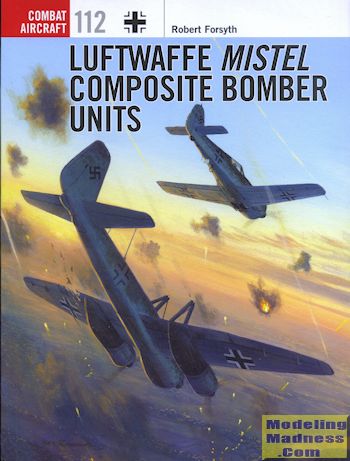 One of
the more unusual weapons systems developed by the Luftwaffe during WWII was the
Mistel or composite aircraft system. Originally it was designed to allow fighter
aircraft to transport gliders full of troops. This was to be accomplished by
using older model Bf-109s along with the DFS-230 gliders. Having the 109 as the
power source for the glider would not only get the glider to its mark, but also
have ready-to-go fighter cover.
One of
the more unusual weapons systems developed by the Luftwaffe during WWII was the
Mistel or composite aircraft system. Originally it was designed to allow fighter
aircraft to transport gliders full of troops. This was to be accomplished by
using older model Bf-109s along with the DFS-230 gliders. Having the 109 as the
power source for the glider would not only get the glider to its mark, but also
have ready-to-go fighter cover.
Initially the project used a DFS-230 glider with first a Klemm Kl-35 and
later a Focke-Wulf FW-56 mounted atop the glider. These planes were unable to
provide sufficient power to get the combination off the ground, but were able to
keep it in the air and help to test the feasibility of the project. These
lighter aircraft also did not put a big strain on the glider as their weight was
within the normal carrying limits of the DFS-230.
This was later tested using a Bf-109E fighter. This provided the power
needed to get the set off the ground, but put strain on the glider, requiring
strengthening of the landing gear, reinforcement of the glider airframe,
developing attachment points for the 109 (the previous aircraft simply sat their
main wheels in a small cradle atop the glider's wing/fuselage join), and a
method of freeing the fighter when it came time to release the glider. These
were eventually solved and by January 1944, all that was needed was the go
ahead.
However, the RLM did not really see any need for a cargo/troop carrying
composite aircraft, despite having a functional and tested system. It took other
plans to bring it all into fruition.
That was the plan for using older Ju-88A-4s and Bf-109Fs where the Ju-88
had the cockpit replaced with a shaped charge warhead and would be used as a
guided bomb to sink ships. Later versions used FW-190s and newer Ju-88s. It was
also planned on using them to destroy hardened, high value targets.
Since the mechanisms were already proven, all that was needed was to
train pilots. This was actually pretty easy as once they got over the fact that,
on the ground, they were several feet higher than normal, it wasn't an issue.
Flying the composite was simple, though one had to take into consideration a lag
in control input, and even taking off was relatively problem free, though the
composite required a clean, hard runway surface.
Without giving anything away, these planes were built with considerable
speed and there were hundreds of them constructed. Unfortunately, as late in the
war as they were ready to use, the Luftwaffe had lost control of the air and
their effectiveness was minimal.
The tale of these aircraft as well as the men who flew them and the
missions they performed makes for some very interesting reading. A host of
period photos is provided as well as several pages of excellent full color
profiles. In all, it is a great read and one that I know you will thoroughly
enjoy.
October 2015
For more on the complete line of Osprey books,
visit https://ospreypublishing.com . In the US, e-mail
OspreyUSA@ospreypublishing.com, to request a catalogue of available books.
If you would like your product reviewed fairly and
fairly quickly, please
contact the editor or see other details in the
Note to
Contributors.
 One of
the more unusual weapons systems developed by the Luftwaffe during WWII was the
Mistel or composite aircraft system. Originally it was designed to allow fighter
aircraft to transport gliders full of troops. This was to be accomplished by
using older model Bf-109s along with the DFS-230 gliders. Having the 109 as the
power source for the glider would not only get the glider to its mark, but also
have ready-to-go fighter cover.
One of
the more unusual weapons systems developed by the Luftwaffe during WWII was the
Mistel or composite aircraft system. Originally it was designed to allow fighter
aircraft to transport gliders full of troops. This was to be accomplished by
using older model Bf-109s along with the DFS-230 gliders. Having the 109 as the
power source for the glider would not only get the glider to its mark, but also
have ready-to-go fighter cover.